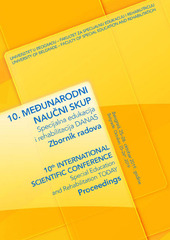Upotreba pravih prideva kod gluve i nagluve dece
The use of descriptive adjectives in partially and completely deaf children
| dc.contributor | Vuković, Mile | |
| dc.contributor | Žunić Pavlović, Vesna | |
| dc.contributor | Grbović, Aleksandra | |
| dc.contributor | Radovanović, Vesna | |
| dc.creator | Veselinović, Ivana | |
| dc.creator | Slavnić, Svetlana | |
| dc.creator | Jeličić, Ljiljana | |
| dc.date.accessioned | 2022-01-18T16:41:29Z | |
| dc.date.available | 2022-01-18T16:41:29Z | |
| dc.date.issued | 2019 | |
| dc.identifier.isbn | 978-86-6203-129-7 | |
| dc.identifier.uri | http://rfasper.fasper.bg.ac.rs/handle/123456789/4102 | |
| dc.description.abstract | U verbalnom izražavanju gluve i nagluve dece pravi pridevi se nedovoljno upotrebljavaju, a i koriste se u drugačijoj funkciji u rečenici, u odnosu na rečenične konstrukcije dece tipičnog jezičkog razvoja. Cilj rada bio je da se utvrdi, uporedi i razjasni upotreba i funkcije pravih prideva u formiranju iskaza kod gluve i nagluve dece i dece tipičnog razvoja. Istraživanjem je obuhvaćeno 130 učenika starijih razreda osnovne škole, oba pola, prosečnih intelektualnih sposobnosti, bez dodatnih oštećenja. Eksperimentalnu grupu je činilo 50 učenika čije je oštećenje sluha preko 70 dB. Ovi učenici pohađali su škole za gluvu i nagluvu decu u Srbiji (40 učenika) i škole za decu tipičnog razvoja (10 učenika). Kontrolna grupa obuhvatila je 80 učenika tipičnog razvoja. Za potrebe istraživanja koristili smo i unapred definisane teme za pisanje četiri sastava različitih žanrova: narativ, deskripcija, ekspozicija i argumentativ, kao i poseban protokol za prikupljanje podataka koji je konstruisan za potrebe ovog istraživanja. Prikupljeni podaci obrađivani su pomoću statističkog paketa SAS 9.3. Pored kvantitativne analize, prikupljeni materijal analizirali smo i kvalitativno. Rezultate istraživanja prikazali smo tabelarno, a najznačajnije rezultate smo i posebno diskutovali. Rezultati istraživanja govore da su deca koja pohađaju škole za gluve i nagluve prilikom formiranja iskaza upotrebila značajno manje pravih prideva od dece tipičnog jezičkog razvoja. Upotreba i funkcije pravih prideva kod dece tipičnog razvoja zavise od pola i razreda koji dete pohađa, a kod gluve i nagluve dece od razreda koji dete pohađa, dominantnog načina komunikacije i dužine primenjenog re/habilitacionog tretmana. Na osnovu rezultata istraživanja zaključili smo da se upotreba pravih prideva u formiranju iskaza povećava sa sazrevanjem i bogaćenjem govorno-jezičkog i vaspitno-obrazovnog iskustva kod gluve i nagluve dece, kao i povećanjem dužine trajanja njihove re/habilitacije na predškolskom uzrastu. | sr |
| dc.description.abstract | During verbal expression, partially and completely deaf children do not use descriptive adjectives sufficiently compared to sentence constructions in children with typical language development. The research aim was to estimate, compare and explain the use and function of descriptive adjectives during statement formation in partially and completely deaf children and typically developing children. The study included 130 children of both sexes, with average intellectual abilities and without additional impairments. All children attended higher classes of elementary school. The sample was divided into three groups: the first experimental group (E) consisted of 40 children whose hearing loss was more than 70 dB and who attended schools for hearing impaired children; the second experimental group (E1) consisted of 10 children whose hearing loss was more than 70 dB and who attended schools for typically developing children. The control group (K) consisted of 80 typically developing children. A special protocol for data collection was constructed. In addition to this protocol, predefined topics for writing four compositions of different genres were used: narrative, descriptive, exposition and argumentative. The research results suggest that partially and completely deaf children who attend schools for hearing impaired children used significantly fewer descriptive adjectives in sentence constructions compared to typically developing children. The use and functions of descriptive adjectives in typical children depend on the sex and the class while in the group of partially and completely deaf children they depend on sex, dominant mode of communication and the length of applied re/habilitation treatment. Based on the obtained results, it may be concluded that, in the group of partially and completely deaf children, the use of descriptive adjectives during statement formation increases with maturation and richness of speech and language and educational experience | sr |
| dc.language.iso | sr | sr |
| dc.publisher | Univerzitet u Beogradu – Fakultet za specijalnu edukaciju i rehabilitaciju/ University of Belgrade – Faculty of Special Education and Rehabilitation | sr |
| dc.relation | info:eu-repo/grantAgreement/MESTD/Basic Research (BR or ON)/179055/RS// | sr |
| dc.rights | openAccess | sr |
| dc.rights.uri | https://creativecommons.org/licenses/by-sa/4.0/ | |
| dc.source | Zbornik radova - 10. Međunarodni naučni skup „Specijalna edukacija i rehabilitacija danas“, Beograd, Srbija, | sr |
| dc.subject | gluva i nagluva deca | sr |
| dc.subject | deca tipičnog jezičkog razvoja | sr |
| dc.subject | pravi pridevi | sr |
| dc.subject | partially and completely deaf children | sr |
| dc.subject | typically developing children | sr |
| dc.subject | descriptive adjectives | sr |
| dc.title | Upotreba pravih prideva kod gluve i nagluve dece | sr |
| dc.title | The use of descriptive adjectives in partially and completely deaf children | sr |
| dc.type | conferenceObject | sr |
| dc.rights.license | BY-SA | sr |
| dc.citation.epage | 423 | |
| dc.citation.spage | 417 | |
| dc.identifier.fulltext | http://rfasper.fasper.bg.ac.rs/bitstream/id/5578/Untitled52.pdf | |
| dc.identifier.rcub | https://hdl.handle.net/21.15107/rcub_rfasper_4102 | |
| dc.type.version | publishedVersion | sr |


